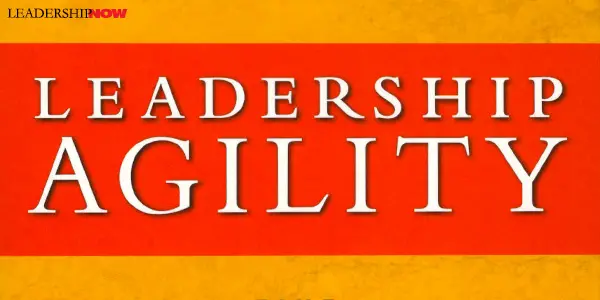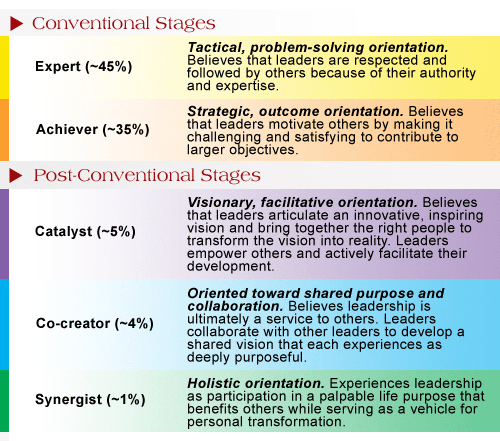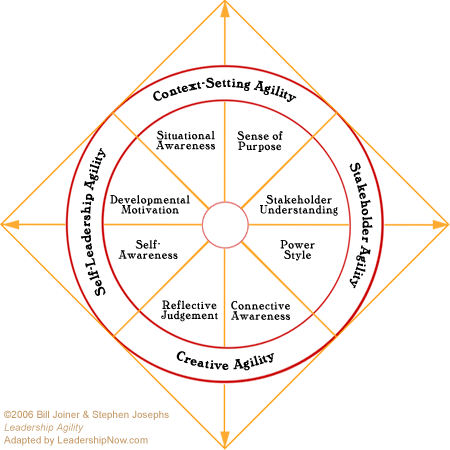 |
 |
12.04.06

Leadership Agility
WHAT IS leadership agility? Like agile organizations—organizations that anticipate and respond to rapidly changing conditions by leveraging highly effective internal and external relationships—leadership agility is the ability to take wise and effective action amid complex, rapidly changing conditions. Leadership Agility is an interesting, thorough, and well-written book and one of the best on the topic. Authors Bill Joiner and Stephen Josephs encouragingly tell us that their research “reveals a significant set of findings about the relationship between personal development and leadership effectiveness: As adults grow toward realizing their potential, they develop a constellation of mental and emotional capacities that happen to be the very capacities needed for agile leadership.”Building on the pioneering work of Piaget and Erickson in mapping the stages of human development from infants to adulthood—the pre-conventional stages—the authors identify three more stages they call the conventional stages: Conformer, Expert and Achiever. And finally, there are the post-conventional stages they call: Catalyst, Co-Creator, and Synergist.  Some people, of course, may never move through all of the stages. Of the 600 managers they studied, most never move beyond the Achiever stage. They write, "Most top executives and administrators, state and national politicians, influential scientists, and other highly successful professionals have stabilized their development at [the Achiever] stage." Only about 10 percent of today’s managers operate at the post-conventional stages of adult development. What does it mean to be at one of the post-conventional stages? Research has shown that people at these post-conventional stages are more deeply purposeful, more visionary in their thinking, and more resilient in responding to change and uncertainty. They’re more welcoming of diverse perspectives and have a greater capacity for resolving differences with other people. They’re also more self-aware, more attuned to their experience, more interested in feedback from others, and better at working through inner conflicts. These stages are sequential and are not personality dependent. In other words, any one can be at any stage but you can move to another stage until you have mastered the one you are at. The question is, “How can we begin to move through these stages of development?” Simply put, you get there by practice—by putting the capacities and traits to work and learning to apply them in various situations. Each stage represents the maturation to a certain point of four competencies and their respective mental and emotional capacities. They state that highly agile leaders orchestrate the four competencies so that they work in concert. They have developed the Leadership Agility Compass to graphically represent these competencies. All eight of the capacities contribute directly to your effectiveness as a leader.  The outer circle on this graphic represents the tasks carried out using the four leadership agility competencies. The middle circle represents the four pairs of capacities that support these competencies. The four mutually reinforcing competencies are: Context-setting agility improves your ability to scan your environment, frame the initiatives you need to take, and clarify the outcomes you need to achieve. It entails stepping back and determining the best initiatives to take, given the changes taking place in your larger environment. Stakeholder agility increases your ability to engage with key stakeholders in ways that build support for your initiative. It requires you to step back from your own views and objectives to consider the needs and perspectives of those who have a stake in your initiatives. Creative agility enables you to transform the problems you encounter into the results you need. It involves stepping back from your habitual assumptions and developing optimal solutions to the often novel and complex issues you face. Self-leadership agility is the ability to use your initiatives as opportunities to develop into the kind of leader you want to be. It entails stepping back; becoming more aware of your thoughts, feelings, and behaviors; and experimenting with new and more effective approaches. After laying this groundwork in far more detail, Leadership Agility provides real life stories to demonstrate what leadership looks like at that level and then clarifies what it takes to move to the next level. You will also learn how to become more effective in your current level of agility. 
Posted by Michael McKinney at 09:02 AM
|
BUILD YOUR KNOWLEDGE
 

How to Do Your Start-Up Right STRAIGHT TALK FOR START-UPS 
Grow Your Leadership Skills NEW AND UPCOMING LEADERSHIP BOOKS 
Leadership Minute BITE-SIZE CONCEPTS YOU CAN CHEW ON 
Classic Leadership Books BOOKS TO READ BEFORE YOU LEAD |